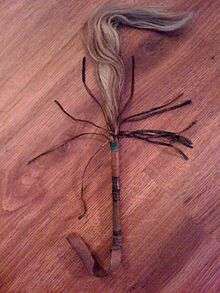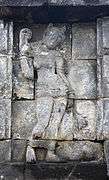Fly-whisk


A fly-whisk is a tool to swat or disturb flies. A similar gadget is used as a hand fan in hot tropical climates, sometimes used as part of regalia, and called chowrie, chāmara or prakirnaka in South Asia and Tibet.[1][2]
In Indonesian art, a fly-whisk is one of the items associated with Shiva. The fly-whisk is frequently seen as an attribute of both Hindu, Daoist, and Buddhist deities.[3] The fly-whisk is evident in some configurations of the Ashtamangala, employed in some traditions of murti puja, particularly the Gaudiya Vaishnava. It is also used as an accessory in the ritual aspects of folk performance traditions, especially folk-theatre forms like Palagaan where it can double as a prop.
Fly-whisks are in use in parts of the contemporary Middle East, such as Egypt, by some classes of society, e.g. outdoor merchants and shop keepers, especially in summer when flies become bothersome. Those have a wooden handle and plant fibers attached to them. The more expensive ones are made from horse hair. In the eastern parts of the Indian subcontinent it is made from the tail-hairs of the yak.
Fly-whisks appear frequently in the traditional regales of monarchs and nobility in many parts of the African continent. This use has sometimes carried on into modern contexts: Kenyan leader Jomo Kenyatta carried a fly-whisk, a mark of authority in Maasai society,[4] as did Malawian leader Hastings Banda, while South African jazz musician Jabu Khanyile also used a Maasai fly-whisk as a trademark when on stage.[5]
The fly-whisk is one of the traditional symbols of Buddhist monastic hierarchy in China and Japan, along with the khakkhara, jewel scepter and begging bowl. The fly-whisk in Buddhism represents the symbolic "sweeping" of ignorance and mental afflictions.
A fly-whisk forms part of the royal regalia of Thailand. It consists of the tail hairs of an albino elephant.[6] Fly-whisks were also used in Polynesian culture as a ceremonial mark of authority.[7]
Algeria incident
In 1827, the last Ottoman ruler of Algeria, Hussein Dey, struck the French Consul in the face with a fly-whisk during a dispute over unpaid French debts to Algeria. This insult became a pretext for the French invasion of Algeria in 1830.[8]
Gallery
 Chamara (fly-whisk) as regalia in Hindu-Buddhist iconography. 8th century Borobudur bas-relief.
Chamara (fly-whisk) as regalia in Hindu-Buddhist iconography. 8th century Borobudur bas-relief. Chamara used in Hindu puja.
Chamara used in Hindu puja._waving_the_Sikh_scripture_to_show_respect.jpg) Orange colored chauri used to fan Sikh scripture in respect
Orange colored chauri used to fan Sikh scripture in respect Chasse-mouches MHNLille
Chasse-mouches MHNLille
See also
References
| Wikimedia Commons has media related to Fly whisks. |
- ↑ Gopal, Madan (1990). K.S. Gautam, ed. India through the ages. Publication Division, Ministry of Information and Broadcasting, Government of India. p. 81.
- ↑ Robert Beer (2003). The Handbook of Tibetan Buddhist Symbols. Serindia Publications. p. 177. ISBN 978-1-932476-03-3.;
चामर, Sanskrit-English Dictionary, Koeln University, Germany - ↑ Shiva and Parvati, Rijksmuseum, accessed 14 November 2006
- ↑ Dress codes and prestige staffs: constructing political authority with staffs in Tanzania, Fadhili Mshana, Ijele: Art eJournal of the African World, 2002
- ↑ Jabu Khanyile, Contemporary African Music and Arts Archive, accessed 13 November 2006
- ↑ Thai Royal Regalia, Thailand Government Public Relations Department, accessed 15 November 2006
- ↑ Fly Whisk Handle, Metropolitan Museum of Art, accessed 14 November 2006
- ↑ "History of Algeria". HistoryWorld. Archived from the original on 2005-09-02. Retrieved 2007-12-19.